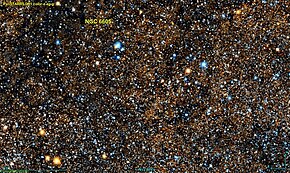
Carina is a constellation in the southern sky. Its name is Latin for the keel of a ship, and it was the southern foundation of the larger constellation of Argo Navis until it was divided into three pieces, the other two being Puppis, and Vela.

Camelopardalis is a large but faint constellation of the northern sky representing a giraffe. The constellation was introduced in 1612 or 1613 by Petrus Plancius. Some older astronomy books give Camelopardalus or Camelopardus as alternative forms of the name, but the version recognized by the International Astronomical Union matches the genitive form, seen suffixed to most of its key stars.

Centaurus is a bright constellation in the southern sky. One of the largest constellations, Centaurus was included among the 48 constellations listed by the 2nd-century astronomer Ptolemy, and it remains one of the 88 modern constellations. In Greek mythology, Centaurus represents a centaur; a creature that is half human, half horse. Notable stars include Alpha Centauri, the nearest star system to the Solar System, its neighbour in the sky Beta Centauri, and HR 5171, one of the largest stars yet discovered. The constellation also contains Omega Centauri, the brightest globular cluster as visible from Earth and the largest identified in the Milky Way, possibly a remnant of a dwarf galaxy.

Dorado is a constellation in the Southern Sky. It was named in the late 16th century and is now one of the 88 modern constellations. Its name refers to the mahi-mahi, which is known as dorado ("golden") in Spanish, although it has also been depicted as a swordfish. Dorado contains most of the Large Magellanic Cloud, the remainder being in the constellation Mensa. The South Ecliptic pole also lies within this constellation.

Sagittarius is one of the constellations of the zodiac and is located in the Southern celestial hemisphere. It is one of the 48 constellations listed by the 2nd-century astronomer Ptolemy and remains one of the 88 modern constellations. Its old astronomical symbol is (♐︎). Its name is Latin for "archer". Sagittarius is commonly represented as a centaur drawing a bow. It lies between Scorpius and Ophiuchus to the west and Capricornus and Microscopium to the east.

Coma Berenices is an ancient asterism in the northern sky, which has been defined as one of the 88 modern constellations. It is in the direction of the fourth galactic quadrant, between Leo and Boötes, and it is visible in both hemispheres. Its name means "Berenice's Hair" in Latin and refers to Queen Berenice II of Egypt, who sacrificed her long hair as a votive offering. It was introduced to Western astronomy during the third century BC by Conon of Samos and was further corroborated as a constellation by Gerardus Mercator and Tycho Brahe. It is the only modern constellation named for a historic person.

Hydra is the largest of the 88 modern constellations, measuring 1303 square degrees, and also the longest at over 100 degrees. Its southern end borders Libra and Centaurus and its northern end borders Cancer. It was included among the 48 constellations listed by the 2nd century astronomer Ptolemy. Commonly represented as a water snake, it straddles the celestial equator.

Aquila is a constellation on the celestial equator. Its name is Latin for 'eagle' and it represents the bird that carried Zeus/Jupiter's thunderbolts in Greek-Roman mythology.
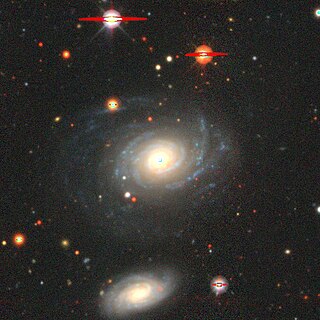
NGC 1 is an intermediate spiral galaxy of the morphological type Sbc, located in the constellation of Pegasus. It was discovered on 30 September 1861 by Heinrich d'Arrest.

Gemini is one of the constellations of the zodiac and is located in the northern celestial hemisphere. It was one of the 48 constellations described by the 2nd century AD astronomer Ptolemy, and it remains one of the 88 modern constellations today. Its name is Latin for twins, and it is associated with the twins Castor and Pollux in Greek mythology. Its old astronomical symbol is (♊︎).
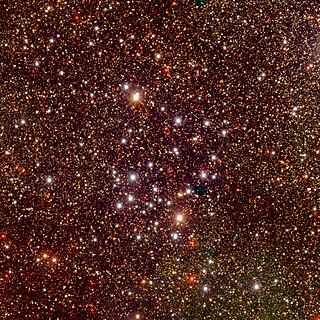
NGC 6281 is an open cluster of stars in the constellation Scorpius. It was not included in the Messier or Caldwell catalogues of nebulous objects, but it is the brightest such cluster in the constellation to be left out of both. It is readily observed with the naked eye; it is located about 2° to the east of Mu Scorpii. James Dunlop described the cluster as a "curiously curved line of pretty bright stars, with many stars mixt". John Herschel then described the cluster as both "pretty bright" and "pretty rich".

NGC 2439 is a sparse open cluster of stars in the constellation Puppis. It has an apparent visual magnitude of 6.9, an angular size of 10 arcminutes, and is visible using a small telescope. This is a young cluster with age estimates in the range of 20–300 million years. It has a tidal radius of approximately 82 light years. No chemically peculiar stars have been found.
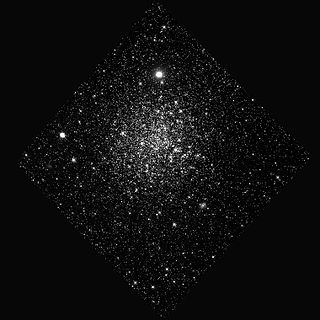
NGC 339 is a globular cluster in the constellation Tucana the Toucan. It is located both visually and physically in the Small Magellanic Cloud, being only about 10,000 ± 12,000 light years closer than the cloud. It is rather prominent, being the brightest cluster in the southern reaches of the cloud. It was discovered by John Herschel on September 18, 1835. It was observed in 2005 by the Hubble Space Telescope. Its apparent V-band magnitude is 12.12, but at this wavelength, it has 0.19 magnitudes of interstellar extinction.

NGC 2164 is a 10th-magnitude open cluster in the Dorado constellation. The celestial object was discovered on September 27, 1826, by the Scottish astronomer James Dunlop. Its apparent size is 2.5 arcmin. It is located in the Large Magellanic Cloud.

NGC 4907 is a barred spiral galaxy located about 270 million light-years away in the constellation of Coma Berenices. It is also classified as a LINER galaxy. NGC 4907 was discovered by astronomer Heinrich d'Arrest on May 5, 1864. The galaxy is a member of the Coma Cluster, located equidistant between NGC 4928 and NGC 4829.
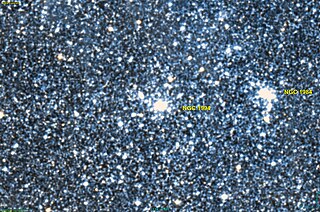
NGC 1994 is an open cluster in the Dorado constellation which is located in the Large Magellanic Cloud. It was discovered by John Herschel on 16 December 1835. It has an apparent magnitude of 9.8 and its size is 0.60 arc minutes.
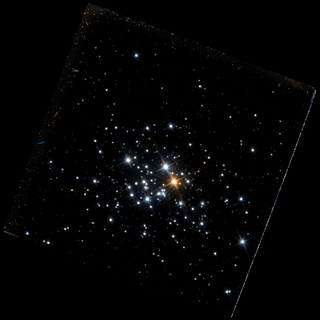
NGC 1984 is an open cluster associated with an emission nebula, it is located in the constellation Dorado in the Large Magellanic Cloud. It was discovered by John Herschel on 16 December 1835. The apparent magnitude is 9.9 and its size is 1.50 by 1.20 arc minutes.

NGC 521, also occasionally referred to as PGC 5190 or UGC 962, is a barred spiral galaxy located approximately 224 million light-years from the Solar System in the constellation Cetus. It was discovered on 8 October 1785 by astronomer William Herschel.
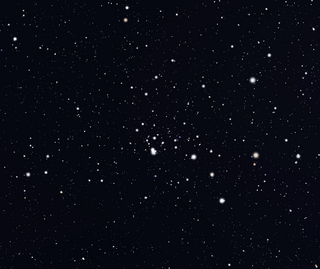
NGC 957 is a loosely bound open cluster located in the constellation Perseus. It has an apparent magnitude of 7.6 and an approximate size of 11 arc-minutes. It is young at less than 11 million years old.

NGC 2353 is a loosely bound open cluster located in the constellation Monoceros. It has an apparent magnitude of 7.1 and an approximate size of 20 arc-minutes. The cluster is dominated by the magnitude 6.0 star HIP 34999, which lies at the southern edge of the cluster.
